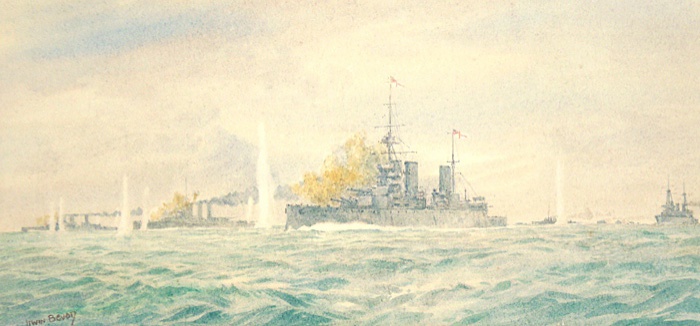Battle cruisers in action: Dogger Bank January 1915
Irwin Bevan (1852-1940). Watercolour signed (LL), undated.
Standard size: 10.5 x 5.25 inches (27 x 13.5 cms) approx (although enlarges very satisfactorily)
Price is available upon request
This original has been sold and is no longer available.
Prints of this may be available on: Maritime Prints.
Detective work leads to the conclusion that this is a painting of the early stages of the Battle of Dogger Bank, 24th January 1915. The weather Bevan has painted fits (unusually for the North Sea it was a clear, cold day with excellent visibility and little wind); and above all the combination of ships and the formation in which they are shown steaming matches exactly a stage of this action. The only piece of this jigsaw that doesn’t fit Dogger Bank, however, is the fact that no ship appears to be flying the flag of Vice Admiral Beatty, Vice Admiral Commanding the Battlecruisers. The cross of St George with one ball in the upper hoist should have been in LION - but here it is nowhere to be seen. As no other ship has any flags at all perhaps Bevan just forgot them? That the ship in question is LION is not in doubt for she was unique in that her mainmast “starfish” was above funnel height (as painted here): and at no stage when in action in WWI was she not a flagship. That missing St George Cross, together with bunting on other ships, simply has to be artist’s oversight!
Germans ships had had considerable success in the early stages of WWI with nipping across the North Sea and bombarding English seaside towns. Catching the Royal Navy off its guard and making it hard anyway for the British to react quickly enough as these raids were executed with no warning and at high speed, the British public’s reaction was predicable: where was the navy that was supposed to be defending against this sort of thing? The raids had taken place against Yarmouth (3rd November 1914); and Whitby, Scarborough and Hartlepool on 15th January 1915. A week or so after this last one the Germans decided to have another go and in the late afternoon of Saturday 23 January three battlecruisers (SEYDLITZ, MOLTKE and DERFFLINGER) and the large armoured cruiser BLUCHER together with four light cruisers and two destroyer flotillas sailed for the vicinity of the Dogger Bank (just about in the geographical centre of the North Sea) where they hoped to surprise light, hopefully unsupported, British forces. But the British Admiralty was at that stage of the war already breaking German ciphers and so Admiral Hipper’s hopes of the sortie being a surprise were dashed: Beatty had been ordered to sea and shortly after Hipper had sailed Sir David too was underway with a healthy supporting team of other heavies and flotillas and destroyers.
Shortly after 0900 the following morning, 24th January, the two forces tangled and in the ensuing action BLUCHER was sunk and LION severely damaged, finally limping out of the action and being taken in tow by INDOMITABLE. Surrounded in a protective screen by an impressive number of escorts, the wounded LION eventually reached the safety of the Firth of Forth.
The painting here shows from left to right HMS PRINCESS ROYAL (Captain Osmond De B Brock ADC RN), HMS TIGER (Captain Henry Pelly MVO RN), HMS LION (Captain Ernle Chatfield CVO RN) flagship of the Vice Admiral Commanding Battle Cruiser Force, Acting Vice Admiral Sir David Beatty KCB MVO DSO; a light cruiser, and on the extreme right HMS INDOMITABLE (Captain Francis Kennedy RN). Ships are clearly giving and receiving fire but LION looks in good shape and has not yet been forced out of line so the time is somewhere around 1000.
Irwin John David Bevan was, we are told, a wealthy man who was able to afford to be an amateur artist, only turning professional when he lost money on the stock market in 1914. He was friends and later a brother-in-law to William Wyllie and it is possibly because of both the latter relationship and Bevan’s undoubted ability with brush and paint that led to Wyllie collaborating with him in producing illustrations for some of Wyllie’s books. Apparently Bevan “did much of the ground work and then handed over the paintings to Wyllie to be finished off and signed by the great master”. This little painting is one of the finest of Bevan’s that this writer has seen - there is a mass of detail in here which allows us perhaps to forgive the omission of “that flag “- an omission that Beatty would probably have been most unwilling to accept!
